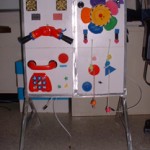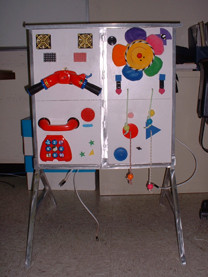Designers: Xin He & Zhiyu Zhu
Client Coordinator: Nancy Curtis, Physical Therapist, North Carolina Easter Seals
INTRODUCTION
More than 500,000 people in the United States are affected by cerebral palsy, which can lead to mental retardation, lack of motor control and growth problems like impaired vision or hearing. Our client “Jenny” is a three-year-old girl with cerebral palsy. Her arms and hands are weak, especially her right hand. She has difficulty stretching her arms out, and as a result she avoids doing so. To address these issues, her physical therapist requested a device that will strengthen her upper arms and trunk muscles. Currently, toys are available in the market aimed at training muscles of children with disabilities using sensory stimulation as an encouragement. The problems with these toys are 1) they provide limited sensory stimulation and fixed stimulation mapping; 2) most of them cannot be mounted vertically, thus the children do not have to reach up to trigger those switches; 3) for most commercial devices, all the sounds are already built in by the manufacturer, thus the child cannot be creative to make her own sounds. The Sound Wall, shown in Figure 1, is an attempt at a treatment device that addresses these shortcomings.
SUMMARY OF IMPACT
We believe this device can help “Jenny” to strengthen her muscles. The major advantages of this device are 1) it is vertically mounted; 2) it is expandable; 3) “Jenny” can be creative while playing with it; and 4) it is quite open-ended for use by any child. A disadvantage of this device is that “Jenny” requires supervision while playing with it.
TECHNICAL DESCRIPTION
The device consists of three major parts: a frame, five function blocks and the power supply. Any combination of four out of the five blocks can be mounted in the frame at a given time. Bright colors and simple shapes were applied for aesthetics. The base consists of two parts – the frame and the supporting structure – that are easily detachable. Composed of aluminum, the base is light but rigid, and the triangular design of the support makes it very stable. All the edges are rounded for added safety. A commercial wall transformer is used to provide a 12-volt power supply, which meets safety standards. A project box with four jacks is located on the back of the frame to provide 12 volts to each block. The power connector of each block is screwed into the jacket, making the connection robust and safe. The back panels containing circuit boards are all covered to prevent injury.
Five function blocks
Motorcycle driving block: This block can provide blowing air and flashing light stimulation. We want the child to stretch both her hands out to hold the motorcycle bar, which upon turning can activate lights and fans on each side in response.
Recorder block: Two pulling switches are mounted on this block – one for recording, and the other for playback. By pulling the switch and holding it, the child will train and strengthen arm muscles. The child may also be creative by making up sounds to record and play back.
Telephone block: Installed in this block are nine push buttons, representing the nine digits on a real telephone. Upon pushing a button, music or a message is emitted from the speaker. A three-way switch located just under the speaker is designed to be adjusted by the parents, allowing each digital button to play three distinct sounds. Another feature of this block is the phone bar. We attached one set of magnetic stones with inverse magnetic polar on the block and another set on the phone bar. Thus the phone bar can be hung on the block very easily in one direction, and impossibly in the other direction. To play with this block, the child is encouraged to push different buttons as well as feel the strength of repulsion and attraction of magnetic stones whing hanging up the phone. All the materials of this block are from a commercial toy phone.
Rotating flower: On this block, two different melodies can be played by either simultaneously pulling two switches or pushing two buttons. A flower rotates, with controllable speed, when either set of switches is closed. This flower is specially composed of very soft fabric with plastic materials inside, so when the flower is touched a paper sound can be heard. The child must use both hands at the same time to receive music feedback. The design purpose of this block is to train muscles of both arms at the same time and stimulate cooperation of the two hands.
Velcro block: A music box is attached to this block by a screw, and several Velcro pads are attached with glue. Design purpose was to show the possibility to expand this project by the user, demonstrating an example of how to mount some simple toys on to the blocks.
Total cost for the sound wall is approximately $742.



University Operator: (919) 962-2211 | © 2024 The University of North Carolina at Chapel Hill |